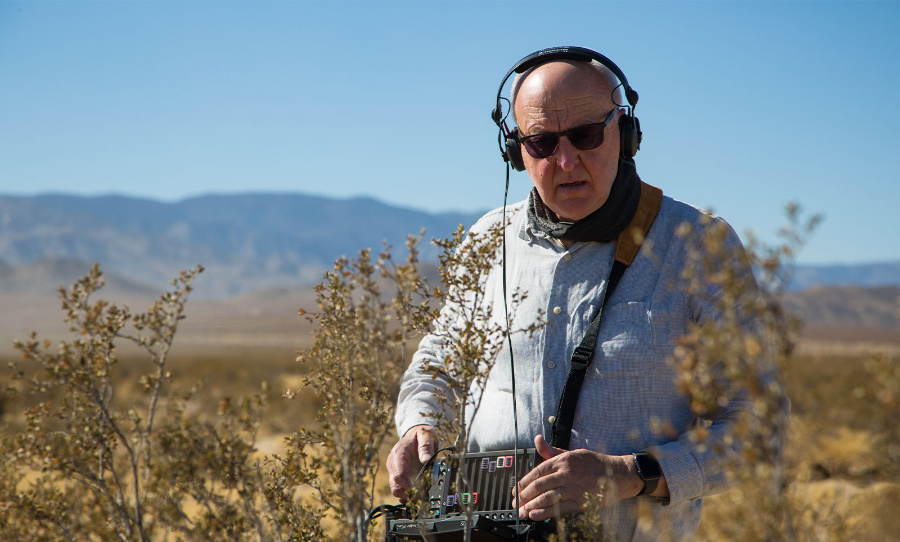Field recording emerged through both experimental and scientific beginnings and it’s always breaking boundaries. Let’s explore the craft of working with found sounds.
To celebrate Sydney Sounds, a series of free sample packs produced by Happy Mag, we’re diving into the audio science behind sampling, field recording, and sample processing. Find out more about Sydney Sounds here.
The art of field recording and incorporating found sounds into music production has a deep history that’s continuously evolving. From fabricating a sense of place in a track to transforming sound sources through DAWs, it can encapsulate a broad range of methods and techniques.
At the heart of it, field recording refers to recording sounds outside of a studio, whether that be a solo acoustic guitar in a forest or ambient chattering in a cafe. But the recording technique isn’t only used for musical listening. In bioacoustics, for example, researchers use natural recordings to analyse how different forms of wildlife communicate with their environments.

Back in the day
In the 1940s Pierre Schaeffer pioneered the term ‘musique concrète’, which essentially refers to using recorded sounds as raw materials. Revolting against conventional music theory, Schaeffer was interested in ‘reduced listening’, separating the sound from its sources, so it can be listened to as sound alone.
He combined found sounds with an early form of studio sampling and along with his contemporary Pierre Henry, opened the doors for a new kind of listening. Schaeffer manipulated his sounds through tape-based techniques, like playing sounds backwards, his experimental methods resulting in a completely otherworldly sound.
In the field
Since the ‘40s, the use of found sounds has become much more common, especially with the rise of sound design in video games, films, and online content. There’s also a range of gear tailored for recording outside of the studio — take the ever-increasing range from Zoom, for example.
Really, all you need to start is a portable recorder. Voice memos for iOS works well for this application, with manufacturers like RØDE and Shure offering some attachable mics that can provide much better sound quality than an inbuilt phone mic. Paired with an inexpensive (or free) DAW like REAPER or Garageband, in 2020 there’s little barrier to begin experimenting with field recording.
Portable gear doesn’t have to be small or surrender sound quality. Pre-eminent sound recordist Chris Watson uses the lightweight 16-track Sonosax SX-R4+ along with a lavalier microphone like the Sanken COS11.
Watson has recorded sound for David Attenborough’s documentaries, while also expanding how recorded sound can exist in music with his own band Cabaret Voltaire and collaborating with artists like Fennesz. Through Watson, we can see the bridge that field recordings build between film and music, and can either stand as their own sounds or be manipulated.
Gaming sounds
Video games are a modern example of where field recordings are being used in a multitude of compelling ways. Many variations of the same source are needed to create a realistic environment, and in combination with sound design and the manipulation of recordings, video games have generated immersive environments that can’t exist in the real world.
Digitally constructed future-scapes, like Halo, can now feel real due to the reality of the recorded sounds. This technique of capturing real-world sounds to represent on-screen visuals is termed Foley and has long been used in filmmaking to enhance the reality of the visuals.
Deep listening
There are still many examples of music being made today that utilises found sounds without sound manipulation. Australian artists like Jim Denley have created deep listening experiences that cannot be separated from the place they were recorded. Through venturing outside and blending landscape, wildlife, and improvised performance, the environmental interaction presents a kind of music that cannot be created any other way.
Another Australian artist, Lawrence English, has risen to become one of the most prolific and renowned field recordists in the world. He blends the in-situ sound with manipulation to create unique, deep listening experiences that are only accessible due to the advancement of recent technology. His record label ROOM40 includes a large catalogue of acoustic and electronic music that incorporates field recordings. If you’re interested in listening to some contemporary music involving field recordings, the label is definitely worth checking out.
The power of the DAW
The transformational power of the DAW has allowed accessible and creative editing and manipulation of sound. Along with being able to record on your phone, and the rise of sampling, found sounds are present in music now more than ever.
Softwares like Ableton Live possess tools that make it possible to completely reimagine found sounds in the box. You don’t need fancy outboard gear, just drag and drop the clip then edit away. The power and breadth of plugins available have led to artists creating incredibly powerful sonic works with minimal gear.
In the video below Eomac demonstrates how a techno track can emerge through a voice memo of birds singing. He achieves this by processing the sounds through envelopes, transposition, EQ, and the drum rack plugin available in Ableton. The final result is vastly different from the sound sources Eomac started with and offers an insight into the transformational power that DAW’s provide, check it out.
Field recording doesn’t mean you have to go outside either. Through opening your ears to everyday surroundings, things like household objects or pets can be made into music. These everyday sounds might not adhere to our Western ideas of rhythms, pitch, or timbre, which in hand opens up some interesting musical possibilities.
In 2020, the aforementioned definition of a field recording being ‘sound recorded outside a studio’ is a touch problematic; now almost every music creator has a home studio. Yet, through investigating its historical roots in experimental music, we can see how field recording, paired with recent technological advancements, can be used to create and break boundaries more than ever before.
To celebrate Sydney Sounds, a series of free sample packs produced by Happy Mag, we’re diving into the audio science behind sampling, field recording, and sample processing. Find out more about Sydney Sounds here.



